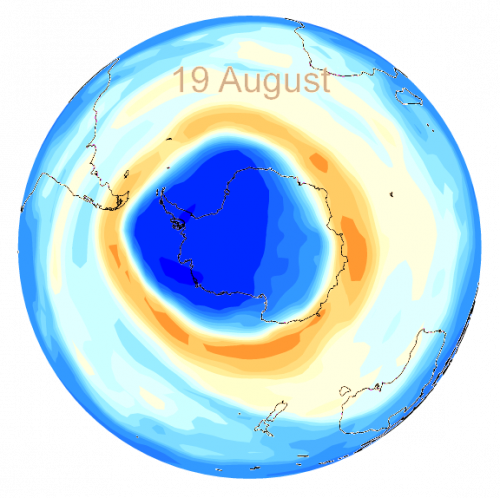Ozone hole history and size
Since the beginning of the eighties one notices that the ozone hole is getting deeper and that the covered surface is getting larger. The phenomenon is observed yearly over the South Pole areas (Antarctica), whereby the amount of ozone in the atmosphere drastically decreases between September and the end of November.
In 1998 the amount of ozone started to decrease already around half of August; the ozone hole covered a record surface of 27 km² on the 19th of September, and on the 30th of September the total amount of ozone above Antarctica decreased to about 90 Dobson units. This means a loss of 70% compared to the average value of 300 Dobson units.
Ozone destruction leading to the ozone hole
Scientific evidence exists for the fact that the release of bromine and chlorine hydrocarbons (CFC's) injects active bromine and chlorine components in the stratosphere, that destroy ozone. These destruction reactions become faster as the local temperature falls, among others by the formation of so-called polar stratospheric clouds that create reactive halogen compounds.
The phenomenon of the ozone hole is reinforced by the presence of the so-called polar vortex, a special circulation pattern in the stratosphere above the South Pole in local winter that isolates this area from its environment: the local stratosphere should be considered as a well closed reaction chamber in which the ozone destruction gets extremely efficient.
Therefore, one observes annual variations as to the size and depth of the ozone hole, as a function of the yearly fluctuations in temperature and in intensity and duration of the polar vortex. The ozone hole is particularly strong above Antarctica; it is observed to a lesser degree above the North Pole. Reasons for this are:
- less severe temperatures
- less intense vortex
The ozone layer is protection against harmful radiations
The dangers of stratospheric ozone decrease are generally known: the stratospheric ozone layer protects the biosphere against the harmful ultraviolet radiations of the Sun, that cause, for example:
- skin cancer
- eye cataract
- damage to plants and marine life
International agreements on ozone depleting subsances, like the Montreal Protocol, aim at the gradual banning of CFC's.



